Let’s keep it real:
Persuading someone to check out your sales page is hard.
You need to guide them through your entire mini sales funnel for that product.
That’s why you want to do everything in your power to maximize the conversion rate of its sales page.
After all, you have already invested time, energy, and money in getting the potential customer to visit it. So you should make it as persuasive as you possibly can.
Today we are going to share ten tips that will help you create a sales page that converts like crazy. Interested?
Continue reading…
#1: Choose the Right Sales Page Format
Traditionally sales pages have been divided into two categories:
- Short-form sales pages
- Long-form sales pages
However, there’s also the third category now, which is video sales pages.
Let’s take a closer look at each of these three sales page formats…
Short-Form Sales Page
A short-form sales page is a sales page that doesn’t feature much copy.
For Example:
Ramit Sethi, a best-selling author and a popular blogger, uses a short-form sales page for his book, “I Will Teach You to Be Rich”.
Above the fold, there’s:
- The headline
- A quick description of the book
- An image of the book
- Two calls to action
- An arrow that encourages you to scroll down

Below that, there’s a video in which Ramit Sethi unboxes the new edition of his book and explains what’s in it.
There’s also a call to action which encourages you to download the first chapter for free.

Then there’s a slideshow composed of eight slides that explain what you will learn by reading this book:

Below the slideshow, there’s social proof in the form of “Featured In” badges of some of the largest newspapers and TV networks in the United States:

Then there’s a quick overview of the six-week plan that Ramit proposes in this book:
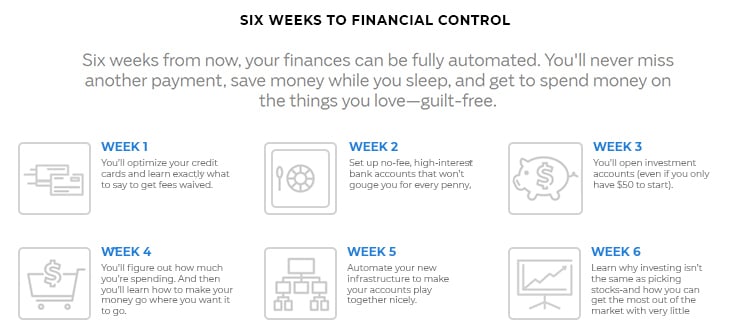
Then there’s a slideshow that features seven glowing reader testimonials:

Below that, there’s an author bio, which also serves as social proof.
Pay attention to how Ramit mentions that he’s a best-selling author and that thousands of readers have used his book to improve their finances.
As you can see, this bio also includes a final call to action which encourages you to get the first chapter for free.

A sales page of this length is considered to be a short-form sales page because it doesn’t feature much copy.
Using a short-form sales page for this book makes sense. It costs less than $10 on Amazon, which is in the impulse buy range. People in Ramit’s target audience don’t need much persuading to go and get a copy.

By the way, having two calls to action on a sales page is not only highly unusual but also goes against one of the most important copywriting rules: one call to action per page.
Of course, Ramit Sethi knows what he’s doing, especially given that someone who downloaded the free chapter is likely to then go and buy the book given its low price.
That being said, you should probably stick to the “one call to action per page” rule, since breaking it can have a disastrous effect on your conversion rate.
Long-Form Sales Page
Long-form sales pages are sales pages that feature a ton of copy.
For Example:
Ramit Sethi uses a long-form sales page for his “Instant Network” online course.
Above the fold, you have a headline, a sub headline, and a few sentences that address the common objections.

Below that there’s social proof in the form of student testimonials:

Then Ramit introduces himself and mentions that he’s an author of a best-selling book. This serves as social proof.

And then there’s the copy. A lot of copy….
Ramit:
- Shares a story of how an intern of his was looking for another internship and Ramit got him one at Gawker.
- Invites the potential customer to imagine having a network like.
- Explains that the older we get, the more our success depends on our network.
- Explains that networking is a skill that you can master.
- Establishes an emotional connection with you by addressing the challenges of networking, the negative connotations of networking, and his own negative experiences with networking.
- Reinforces the importance of having a personal network by discussing scenarios in which you have to make a decision and need advice.
- Strengthens the emotional connection with you by sharing his own story of how he built a powerful network despite starting out as an ordinary middle-class guy with no connections.
- Explains that you don’t need everyone in your network, you only need 10 right people.
- Introduces his “Instant Network” course, explains what you will learn, and provides student testimonials.
- Answers frequently asked questions.
- Explains who this product is not meant for and who it is meant for.
- Offers a 60-day money-back guarantee.
- Displays a prominent call to action.
- Explains why it’s important to start building your network now.
- Displays a second call to action.
This sales page is more than 5,000 words long!
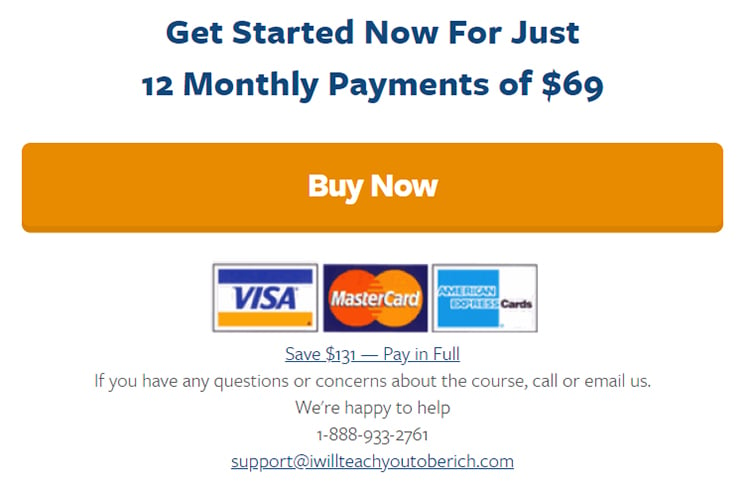
Video Sales Page
Now that video content is:
- More popular than ever
- Easy to host
…some entrepreneurs choose to do away with the traditional short-form and long-form sales pages and use video sales pages instead.
A video sales page is a short-form sales page on which pretty much the entire sales pitch is presented in the video format.
For Example:
A world-renowned dating coach Matthew Hussey uses a video sales page for his online course “Attraction to Commitment”.
It features a 53-minute video:

Short-Form vs. Long-Form vs. Video Sales Pages
So how can you pick the right sales page format for your product?
Here’s the general rule:
The more expensive the product, the longer the sales page should be.
That being said, an argument could be made that using a long-form sales page for an inexpensive product might make sense. Why?
Because it can help you increase the perceived value of that product in the eyes of the potential customer even if they don’t read through the entire page.
In fact, here at ClickFunnels, we use long-form landing pages for our co-founder Russell Brunson’s books, even though we are giving them away for free.
So if you have an affordable product, you may want to create both a short-form sales page and a long-form sales page, then test them against each other to see which one performs better.

Now, when it comes to video sales pages, they work best when you:
- Are great on camera
- Have a popular YouTube channel
For Example, Matthew Hussey:
- Is great on camera due to his vast experience (he creates videos for YouTube, does video podcasts, sells video courses, regularly appears on TV, etc.).
- Has a YouTube channel with 2.99 million subscribers.
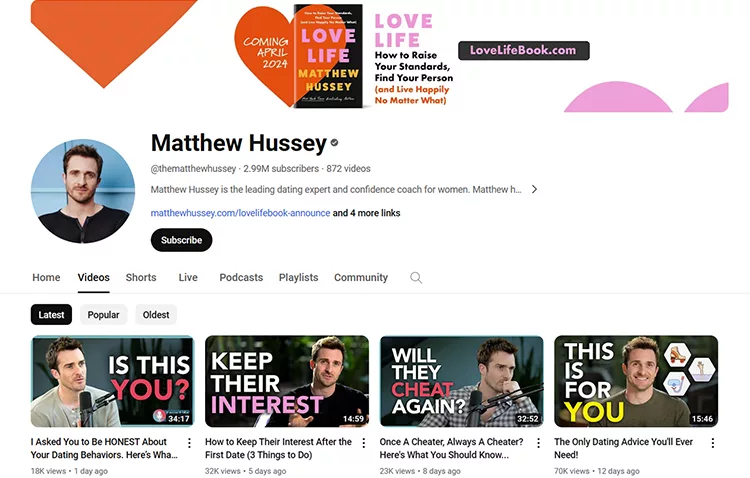
This means that a potential customer who visits the “Attraction to Commitment” sales page is likely to have already seen at least a few of Matthew’s videos.
That’s why a video sales page makes perfect sense in this situation. It provides seamless transition from the YouTube videos to the sales pitch.
#2: Have a Benefit-Driven Headline
The distinction between features and benefits is one of the most important concepts in copywriting:
- Features are the qualities and features of a product. E.g. “These shoes are waterproof!”.
- Benefits are the benefits that the potential customer will derive from the product. E.g. “These shoes will keep your feet warm!”.
You need to focus on the benefits throughout your sales page if you want it to convert well.
This starts with a benefit-driven headline. How will your product make the potential customer’s life better?
For Example:
Brennan Dunn sells a course called “Double Your Freelancing Rate”.
Here’s the headline that he uses on its sales page:
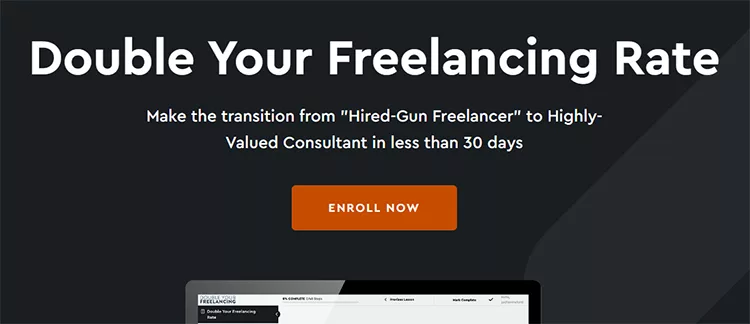
#3: Have a Benefit-Driven Subheadline
You should also have a benefit-driven subheadline that provides more information about the value that the potential customer will get from your product.
For Example:
Brennan Dunn uses this sub-headline on the “Double Your Freelancing Rate” sales page:
“Make the transition from a Hired-Gun Freelancer to Highly-Valued Consultant in less than 30 days”
Note how powerful this combination of a benefit-driven headline and a benefit-driven subheadline is.
It makes it immediately clear why you should buy Brennan’s course.
#4: Establish an Emotional Connection First
You shouldn’t go straight into selling your product on a long-form sales page or a video sales page.
Instead, you should establish an emotional connection by:
- Making the potential customer feel that they are not alone
- Making the potential customer feel that you understand what they are going through
- Making the potential customer feel like there’s hope for them by sharing your own experience
This not only helps to build rapport but also drudges up the feelings related to the problem in question, both the negative ones and the positive ones, which heightens the potential customer’s interest in solving it.
For Example:
Ramit Sethi does this brilliantly on “The Finisher’s Formula” sales page.
Above the fold you see an emotion-driven headline instead of a benefit-driven headline (this is an advanced copywriting technique):

Then you see three Reddit comments, including this one:

Then Ramit:
- Asks “What’s going on here?” and discusses how we live in the most privileged time in history, yet can’t seem to decide what to do with our lives.
- Points out that there are “Too many options – and no way to choose” and explains that “in a world of infinite choice, making a single decision becomes increasingly tough”.
- Mentions that our parents don’t understand this problem.
- Says “it’s not just you…” and shares three more Reddit comments, including this one:

- Continues talking about the overwhelming amount of options that we are faced with throughout our lives.
- Explains that the worst thing about this lack of accomplishment is that we end up giving up on ourselves.
- Uses three more Reddit comments to illustrate this sense of disappointment in oneself, including this one:

- Continues on the topic of giving up on oneself and discusses how negative self-talk leads to an undesirable change in identity which then further impedes our progress.
- Shares six more Reddit comments including this one:

…and only then does he introduce his online course:
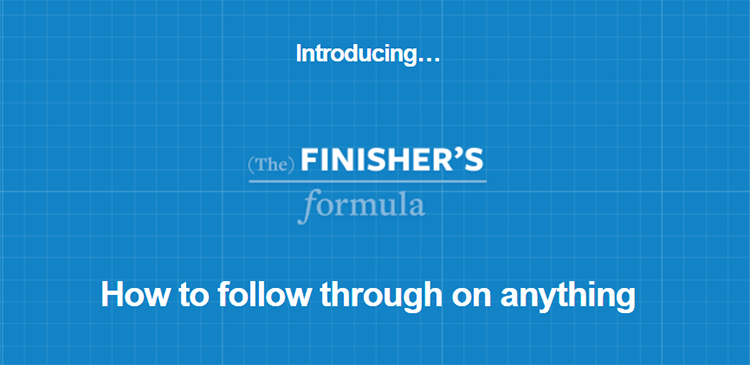
By that time, assuming that you are in the target audience for this product, you feel:
- That you are not alone
- That Ramit understands you
- The pain of underachievement
It’s also worth noting that establishing an emotional connection is especially important when a product addresses a problem that has a lot of shame associated with it (as is the case with “The Finisher’s Formula”).
When you are offering a solution for a problem that people are ashamed about, it’s extremely important to make it clear that you are not judging them.
#5: Sell on Benefits, Not on Features
As we have already discussed, you should focus on the benefits of your product throughout the entire sales page.
You want to hammer home the value that the potential customer will get from buying it. How will your product make their lives better?
For Example:
Nathan Barry sells a book on self-publishing called “Authority”.
He focuses on these two key benefits on its sales page:
- Money
- Lucrative career opportunities
He leads with the former…

…and the moves on to the latter.
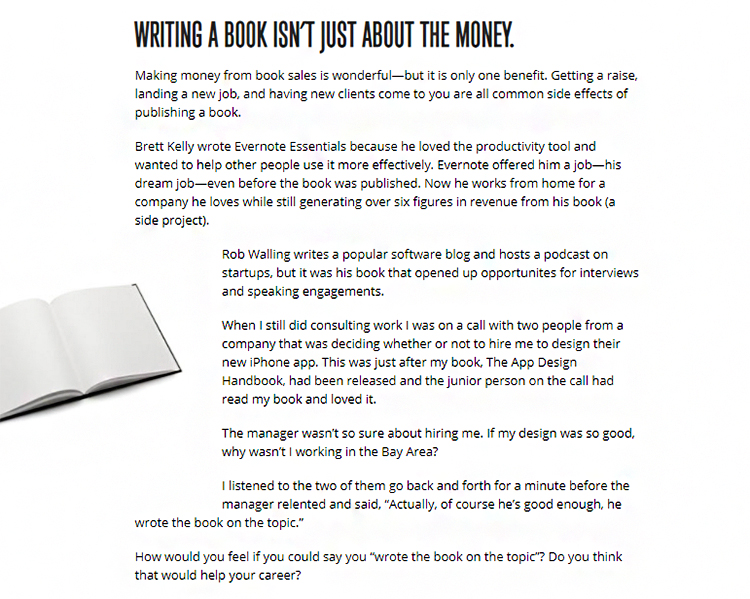
Note how he encourages the customer to imagine what it would be like to enjoy this benefit:
“How would you feel if you could say you “wrote a book on the topic”? Do you think that would help your career?”.
#6: List the Features… In a Benefit-Driven Way!
Of course, you do need to list the features at some point, since the potential customer is unlikely to buy your product if they don’t know what is included in the price.
That being said, when you talk about the features of your product, you should still do it in a benefit-driven way!
For Example:
Take a look at how Ramit Sethi lists “The Finisher’s Formula” features on its sales page.
See how he explains what you will get if you buy the course but still focuses on its benefits while doing it?

#7: Provide Social Proof
When we are unsure of what to do, we look at what others do.
This means that when a potential customer is unsure about buying your product, they will seek reassurance by looking at what other people think about it.
That’s why it’s so important to provide them with as much social proof as you can in the form of:
Customer Logos
This applies to B2B sales pages.
Display the logos of the companies that are already using your product.
Customer Testimonials
Keep in mind that customer testimonials have to not only be real but also look real.
Consider displaying the customer’s:
- Photo
- Full name
- Company
- Job Position
- Social media handle
All this helps to reassure the potential customer that this is indeed a real person.
Avoid displaying testimonials that look fake (e.g. “‘This product is amazing!’ says Jane from the UK”).
“As Seen On” Media Badges
Has your product been covered by the media?
Then you should display the badges of those outlets.
And if your product hasn’t been covered by the media… Well, why not? Go out there and get those media mentions!
Relevant Data
This can be anything that indicates that other people have a positive opinion of your product:
- Number of book copies sold
- Ratings on relevant platforms such as Amazon
- Rankings on best-seller lists such as The New York Times best-seller list
…etc.
Relevant Accomplishments
Your bio should explain why people should listen to you.
Mention any relevant accomplishments that you are proud of, such as being a:
- Successful entrepreneur
- Best-selling author
- Speaker at prestigious conferences
- Recipient of a prestigious award
…etc.
In other words…
Provide an answer to this question:
Why should the potential customer believe that you know what you are talking about?
If You’ve Got it, Flaunt it!
Arguably, there’s no such thing as too much social proof, provided that it doesn’t distract from the product itself.
Which is why the #1 rule of social proof is this:
If you’ve got it, flaunt it!
For Example:
James Clear features a ton of social proof on the “Atomic Habits” sales page.
Above the fold you see:
- “The Instant Worldwide Bestseller”
- Top rankings on prestigious bestseller lists
- “Over 4 million copies sold”
- Quotes from Mark Manson and Arianna Huffington

Then as you scroll down the page you come across testimonials from a bunch of well-known people including famous entrepreneurs, authors, and media personalities:

Further down the page, there is a James Clear’s bio that is chock-full of social proof:
- “..author of the New York Times bestseller…”
- “His work has appeared in Entrepreneur magazine, Time magazine, the New York Times, the Wall Street Journal and on CBS This Morning.”
- “His website, jamesclear.com, receives millions of visitors each month and hundreds of thousands subscribe to his popular email newsletter.”
- He is a regular speaker at Fortune 500 companies and his work is used by coaches and players in the NFL, NBA and MLB”.
You’ve got to admit, that’s pretty impressive!

Then, as you scroll down…
Remember the content that was displayed above the fold?
Well, here it is again, in case you missed some of that social proof the first time:

Finally, near the bottom of the page, there are Goodreads reviews which are seemingly filtered to only show 5-star ratings:

#8: Offer a 30-Day or a 60-Day Money-Back Guarantee
The problem with buying products online is that you can’t check them out without paying. This is especially true for digital products like ebooks and online courses.
You don’t want the fear of buyer’s remorse to prevent someone from becoming a paying customer. But how can you relieve it?
Simple:
Offer a no-questions-asked money-back guarantee. It should be at least 30-days but 60-days is probably better.
This has two key benefits:
- It completely eliminates the financial risk of buying your product.
- It makes you appear confident in the quality of your product which in turn increases the potential customer’s confidence in it.
And don’t worry about getting bankrupted by refunds. Customers rarely ask for them if the product meets their expectations. People are surprisingly honest in this regard.
And if they are unhappy with your product, you wouldn’t want to keep their money anyway, would you?
For Example:
Ramit Sethi provides a 60-day money-back guarantee on “The Finisher’s Formula” sales page.
As you can see, it’s so prominent that you can’t miss it:
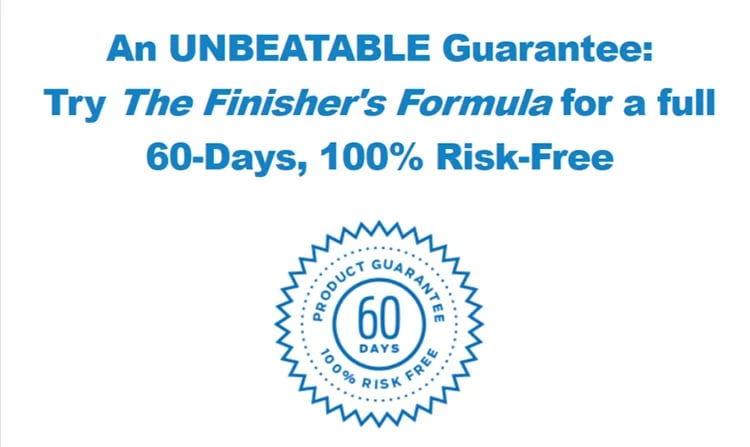
Moreover, he then elaborates on this guarantee, reassuring you that you will definitely get your money back if you ask for a refund within 60-days.

#9: Have a Clear Call to Action
Pretty much the worst thing you can do when selling is be like “So here’s my product…” and then leave it at that. You need to close the sale!
That’s why it’s so important to have a prominent call to action on your sales page. Make it clear what the potential customer should do next.
For Example:
Right below the 60-day money-back guarantee on “The Finisher’s Formula” sales page that we have just discussed Ramit Sethi has this call to action:

#10: Continuously A/B Test Your Sales Page
Here’s the thing:
The only way to figure out what works and what doesn’t is to A/B test your sales page.
Here’s how you can do it:
- Create two variants of your sales page – They should look exactly the same except for the element that you are testing (e.g. the headline, the testimonials, the call-to-action-button color, etc.).
- Split the traffic between the two variants – Send 50% of it to the variant A and 50% of it to the variant B.
- Keep the winning variant – Once the experiment has run its course, analyze the results, then keep the page that converted better.
Note that it’s extremely important to only test one page element at a time.
When you have a lot of ideas, it might be tempting to make several changes at once but that beats the purpose of A/B testing. How will you know which change led to an increase in the conversion rate?
Also, if you are serious about A/B testing, then you should read up on relevant statistics.
Don’t worry, you won’t need to do any math yourself, any decent software will take care of that. But you still want to understand the underlying principles.
Conclusion
Implement the tips that we have shared in this article and you will almost certainly see an increase in the conversion rate of your sales page.
That being said, it’s important to understand that what happens before the potential customer gets to the sales page is just as important as the sales page itself.
You need to pay attention to the entire sales funnel as a whole if you want to maximize your revenue.
Our co-founder Russell Brunson has created a system for converting visitors into leads, leads into paying customers, and paying customers into repeat customers.
It’s called the Value Ladder sales funnel and it’s what Russell and his co-founder Todd Dickerson used to grow ClickFunnels from zero to $10 million in annual revenue in just one year.
Want to learn more about it?
Our 5 Day Challenge will show you exactly how to implement it in your business.
You will learn how to:
- Generate unlimited leads
- Create your first lead magnet
- Build your first sales funnel
- Create a simple 6-email follow-up sequence
- And launch your funnel!
…in just five days.
So don’t hesitate.





